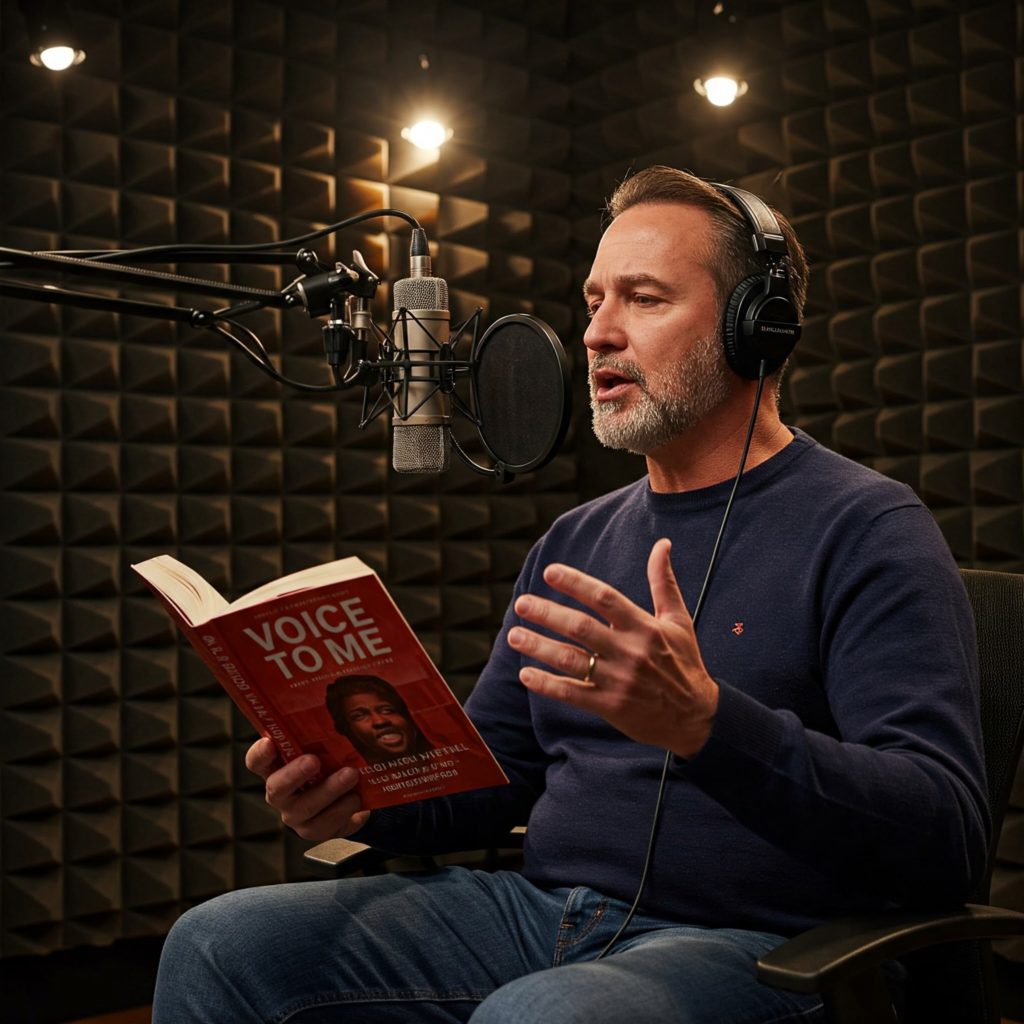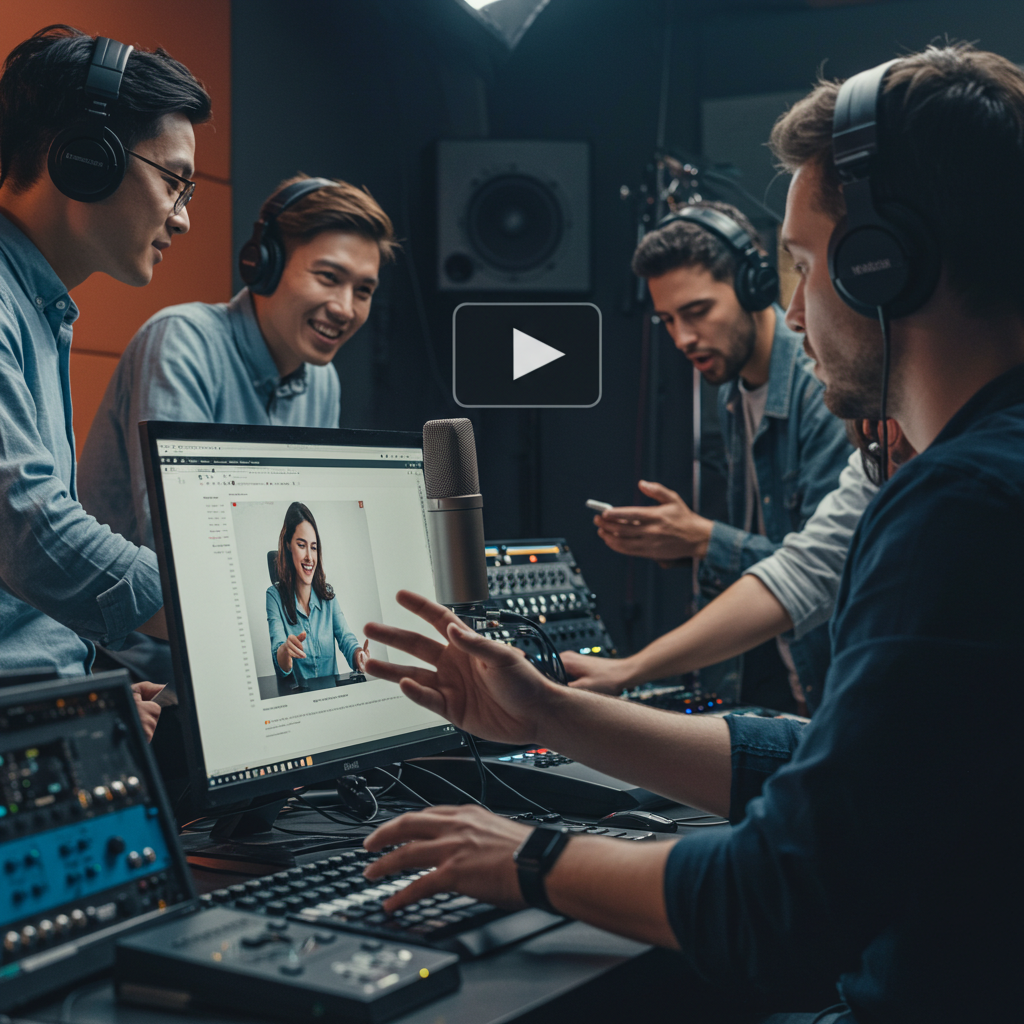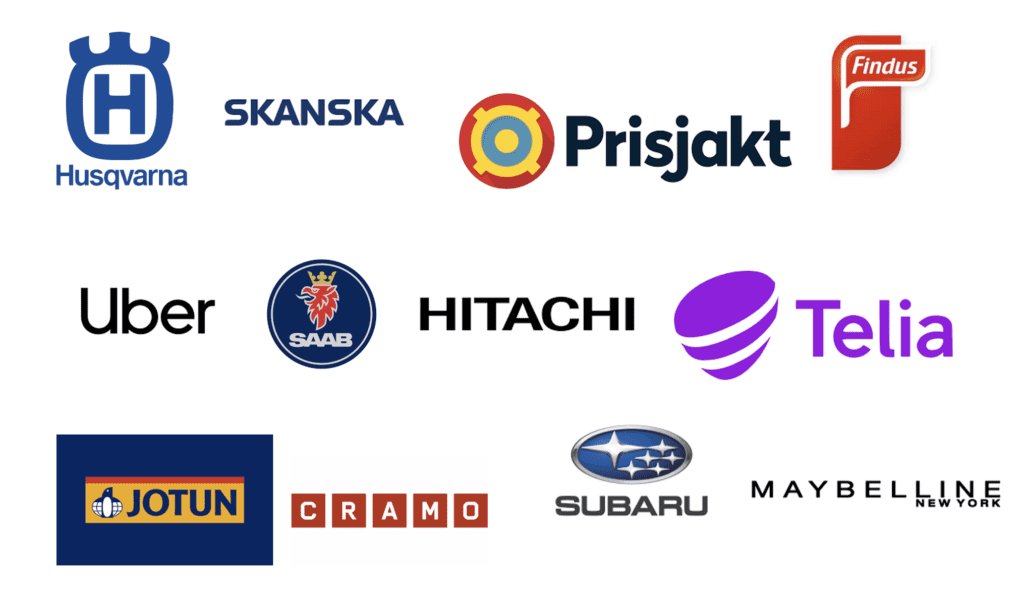



Audiobooks have experienced an enormous surge in popularity in recent years, and for many, it is now the preferred way to consume literature. Furthermore, the voice acting plays a crucial role in making an audiobook truly captivating. A professional voice actor can give life to characters, create atmosphere and draw the listener into the story in a way that the text alone cannot. For authors and publishers, it is therefore important to choose the right voice to captivate listeners through their performance.
Voice To Me is a network of professional voice actors with experience in audiobook narration. Our platform makes it easy to search, listen to samples, and get in touch with the voice that suits your needs. We understand the importance of a high-quality voice and collaborate only with the best talents in the industry.
Captivate your listeners with a professionally narrated audiobook. Find the right voice for your story at Voice To Me.


In today’s digital landscape, videos are a powerful tool for communicating with your audience, whether it’s showcasing your company, promoting a product, or training your employees. A crucial factor in creating engaging corporate videos is selecting the right voice over talent. Professional voice over services such as a voice archive or voice bank can elevate your video from good to great, ensuring your message resonates effectively with your Nordic target audience.
At Voice To Me (www.voicetome.com), we have a wide selection of professional Nordic voice actors with diverse styles and experiences. Our user-friendly search function makes it easy to find the perfect voice for your corporate videos. Whether you need a warm and friendly voice for a customer presentation or an authoritative voice for an internal training video, we have the talent you’re looking for. If you need tips or advice regarding voices, you are always welcome to contact us. Our coordinators Anna and Anna are always ready to help you.
Create engaging and effective corporate videos that resonate with your Nordic audience using professional voice over services from VoiceToMe. Visit www.voicetome.com to explore our range of voices and get started on your next video project.
Why choose Voice to Me? A deep dive into voice archives
A Human Voice: The Key to Touching and Engaging Your Audience
Before you order or contract a voiceover artist, it’s crucial to understand their usage rights and voiceover licenses, which determine how their voice can be used. Common to all rights and licenses for voiceover work is that they ensure the voiceover is used correctly and fairly. Let’s take a closer look at what the different usage rights entail in voiceover rights and licenses.
If you haven’t hired a voiceover artist before, licensing is often a confusing part to understand in the artist’s contract. Therefore, we will try to make the whole process a little easier for you. Let’s start by explaining what the license does. The license sets the framework for how the voice recording can be used – either in broadcast or non-broadcast, depending on voiceover rights and licenses. This means that when your company enters into a license agreement with the voiceover artist, it establishes the terms of use for the voice recording. The following questions are relevant:
Similarly, these questions also come into play when determining the price of the license. For example, whether the voice recording will be used in a single country or globally. Whether it will be used on one platform or several. Or whether it will be used for one or three years. The license agreement thus ensures that your company has the legal right to use the voice recording in either broadcast or non-broadcast media. However, as a company, you do not own the voice recordings themselves. Instead, you purchase a license to use them in your products. This is an important part of voiceover rights and licenses. Let’s look at the difference between broadcast and non-broadcast:
Broadcast refers to the transmission of content via TV, radio, or streaming services to a broad audience. This means that you as a company with a broadcast license pay for media rights to TV, radio, or streaming services when using the voiceover.
Non-broadcast is the opposite. In this case, it’s not about broadcasting on traditional channels but instead covers all entertainment that people can watch or listen to at their own choice. This means that the non-broadcast license includes online videos, advertisements, film trailers, content on social media platforms, games, podcasts, and audiobooks with voiceover rights and licenses.
Although a voice recording can be protected by copyright, the voice itself cannot. This means that if you record a voice, you can protect the recording but not the voice itself as a unique sound. For example, when a voiceover artist voices a character in a film or computer game, the specific voice performance constitutes an original work that can be protected by copyright. Thus, voiceover artists’ vocal performances can be copyrighted in the same way as a musical performance in a song. It is important to note that although copyright is often transferred to companies in commercial situations, the voice actor usually retains the moral rights. These ensure that he or she is recognized as the one who performed the work.
We have compiled some useful tips to help you navigate the process of hiring a voiceover artist for your project and understand voiceover rights and licenses:
If you are not entirely sure how licenses and rights around a voice recording work, you can let a voiceover agency do the job for you. When you order a recording through an agency, you can feel safe and secure that all voiceover rights and licenses are handled correctly by the agency.
Feel free to contact one of our voiceover specialists at Voice To Me Voiceover Agency if you have any questions or concerns. You can find more information at www.voicetome.com.
A Voice to Count On: A Deep Dive into the Voiceover World(Öppnas i en ny webbläsarflik)
A beginner’s guide to becoming a professional voiceover artist(Öppnas i en ny webbläsarflik)


In today’s interconnected world, reaching international markets is crucial for businesses. Specifically, this is often achieved through digital training, social platforms, advertising, and other media. Therefore, this content and these productions require voices that speak to a broad audience, regardless of language or culture. Furthermore, working with professional voice recordings for a diverse audience presents both opportunities and challenges. Ultimately, choosing the right voice-over is essential because the right voice must create a sense of recognition and understanding among people from different regions. While this global reach offers great opportunities, conversely, it also involves significant challenges. Herein, we explore these challenges and explain why authenticity in voice recordings is so important. In essence, producing multilingual voice recordings involves both opportunities and challenges.
Finding Authentic Voices: Authentic performances require a deep understanding of regional dialects, cultural nuances, and emotional undertones, not just linguistic fluency. Choosing the right voice-over can help address these challenges.
Maintaining Consistency:
Creating a unified brand voice across different languages is difficult due to the unique styles and tones of various voice actors.
Cultural Nuances: Understanding and adapting to cultural expectations and emotional triggers is crucial for reaching diverse audiences.
Synchronization Issues:
Different languages have varying word counts, which affects timelines. Careful adjustments are needed to preserve the message’s integrity within specified time frames.
Scalability:
Scaling up voice recording projects for multiple languages can be time-consuming and resource-intensive, so choosing the right voice-over is paramount.
Wider Market Reach: Multilingual voice recordings extend your reach to a global audience, increasing potential revenue and engagement.
Increased Engagement: Using native speakers creates a deeper emotional connection with the audience, making the content more relatable and increasing retention.
Competitive Advantage: Offering high-quality multilingual content provides a competitive edge in global markets, especially where localized content is highly valued.
Building Brand Trust: Consistently high-quality and culturally aware voice recordings build brand identity, credibility, and reliability internationally. When choosing the right voice-over, it’s important to consider these factors.
The Importance of Precision: Choosing voice actors who are both linguistically skilled and culturally attuned is crucial to ensure the voice recording enhances the overall impact of the content.
Producing voice recordings for multilingual markets involves unique challenges and opportunities. Successfully navigating these challenges is essential to ensure that the voice recordings are authentic, culturally relevant, and effective in engaging diverse markets and target audiences.
The main challenges include:
Finding Authentic Voices
Maintaining Consistency
Cultural Nuances
Synchronization Issues
Scalability Choosing the right voice-over can help mitigate these issues.
While multilingual audio production presents challenges, it also opens up a world of opportunities. Successfully leveraging these opportunities can significantly increase a brand’s global reach and engagement. This is why choosing the right voice-over is so important.
The key opportunities include:
Wider Market Reach
Increased Engagement
Competitive Advantage
Building Brand Trust Choosing the right voice-over can enhance each of these opportunities.
www.voicetome.com‘s Unique Approach:
www.voicetome.com focuses on finding the perfect match through a thorough selection process. We evaluate multiple talents until we find the ideal voice that fits the project’s requirements.
Multilingual Expertise:
www.voicetome.com excels in multilingual production by offering efficient solutions. Our approach allows for the handling of different languages within a single session, ensuring consistency and saving time.
Choosing the Right Voice:
Choosing the right voice involves matching the voice actor’s tone and style with the brand’s identity and message. The chosen voice should reflect the desired emotions to ensure the message is delivered effectively. www.voicetome.com offers a wide range of voice talents, making it easier to find the perfect match for any project.
Why Choose www.voicetome.com?
The quality of audio production is crucial. Professional recording equipment and studio acoustics ensure the final product is of the highest standard. www.voicetome.com offers translation, recording, editing, and mastering services of the highest quality. All with real voices and with full quality assurance.
Conclusion:
Multilingual audio production involves unique challenges and opportunities. Therefore, by emphasizing authenticity, ensuring consistent quality, and leveraging the benefits of professional voice recordings, businesses can increase their reach and create deeper connections with their audiences. Specifically, www.voicetome.com
offers comprehensive services that overcome these challenges. Ultimately, visit www.voicetome.com to discover the possibilities of choosing the right voice-over.


In an increasingly globalized world, it’s easy to overlook the power of the local touch. As a matter of fact, when it comes to selecting a voiceover, particularly for the international market, adapting your message linguistically and culturally is crucial. This ensures that you truly resonate with your audience. Whether you’re an international company aiming to market yourself globally, or a voice actor looking to expand your opportunities, understanding how to optimize your voiceover delivery for diverse markets is essential. Remember, achieving a local voice with global reach can make all the difference.
Every region has its unique linguistic culture and consumer mindset. While many people around the world are proficient in English, most prefer to consume content in their native language. This is particularly true for marketing, education, and information that directly affects them. A voiceover that speaks fluently and naturally, with the right tone and dialect, can make a significant difference. This helps in achieving a local voice while ensuring a global reach for your message.
Voice To Me is a leading voiceover service that specializes in connecting international businesses and organizations with professional voice actors. This ensures that your project has a local voice but can achieve a global reach. Our platform offers:
Whatever your voiceover needs internationally, Voice To Me can help you find the perfect voice to elevate your project. Visit www.voicetome.com today and discover the power of a local voice with global reach.


To succeed in narration, one must find the perfect voice that can captivate and engage listeners.
In today’s digital world, audio is a crucial part of communication. Whether you’re producing commercials, videos, audiobooks, or other audio content, the right voice can elevate your project to new heights. But how do you find the perfect voice, especially if you need recordings in multiple languages? The answer is a voice bank!
A voice bank or voice archive is an invaluable resource for anyone who needs professional voice recordings. Here are some advantages:
Voice banks are relevant to a variety of professional groups, including:
Whether you need a voice in Swedish, English, Spanish, or any other language, you can find the perfect voice at www.voicetome.com. Explore our extensive selection of voice actors and take your audio content to the next level.
Visit www.voicetome.com today and find the voice that brings your project to life!
Find the right voices for your radio commercial


This week, we are delivering voiceovers for:
Prisjakt – Online commercial
Eldsprungen – Audiobook
Uber – commerical
Smart Photo, Tv commercial
Bergkvara buss, radio commercial
Brandfarliga arbeten, e-learning English, Polish, Lithuanian, Russian, Spanish
Saab – Information English
Maybelline, national TV commercial
NTA skolutveckling – audiobook
Leos lekland – online commercial, swedish, finnish
Hedin Automotive – national radio commercial
Läkarmissionen – commercial
Skanska – information films
Sandviken kommun – social media
Häagen-Dazs – commerical
Fagerhults belysning – social media
Återvinningsgalan – presentation
Husqvarna automower – commercial, dutch, Spanish, Finnish, Italian, Czech, German, Hungarian
World of toys, radio commercial
Hello clean, radio commercial
Wapnö Gård, commercial
Munch museum, audio guides, Mandarin, Japanese, Spanish
Jotun, social media
Norske skog, social media
Revaxör, commercial, swedish, danish, norweginan
Loomis, social media, english
Evidensia, Phone prompts, english
Södra hallands kraft, commerical
Cramo, information films
Telia norge, phone prompts, norwegian
SmartPhoto, tv commercial
Hitachi, social, media, english
Subaru, radio commerical
Bipasser, commercial
Findus, commercial
Allente, national tv commercial


Choosing the right voice agent can be critical to the success of your project. When browsing through different voice archives, let’s compare Voice to Me with other popular options like Voice123, Fiverr, Voices.com and Bodalgo.
Personal touch: Voice to Me places great emphasis on creating a personal relationship between you as a customer and the voice actor. They often offer the opportunity to leave detailed instructions and receive feedback throughout the process. This can be recorded in their extensive voice archives.
Nordic focus: If, for example, your project requires a Swedish voice with perfect pronunciation and understanding of the Nordic market, Voice to Me can be an excellent choice. They often have a larger database of Swedish, Norwegian, Danish and Finnish voice actors.
Niche specialization: Maybe you’re looking for a voice with a specific dialect or a voice that’s perfect for a certain genre? Voice to Me has a wider range of niche specialized voices. They are often archived for easy access.
Customer support: The quality of customer support can vary between different platforms. Research which platform offers the best support and is easiest to reach. Good support may also help you navigate through voice archives more effectively.
Voices.com, Voice123, and Bodalgo: These platforms often offer a large selection of voices from around the world. However, they can sometimes lack the personal touch and specialization that Voice to Me can offer. They may also have a more generic search function, which can make it harder to find exactly the voice you’re looking for compared to searching through curated voice archives.
You value personal service: If you want to have a close collaboration with the voice actor. You want to be able to influence the result directly.
You need a specific Swedish voice: If you are looking for a voice with perfect Swedish pronunciation and with an understanding of the Swedish market. These are stored in reliable voice archives.
You have a niche project: If you need a voice with a specific dialect or for a certain genre.
You want a quality guarantee: Voice To Me provides a 100% customer satisfaction guarantee. This means you never have to worry that the end result will not be exactly as you imagined.
You want free demos: Not all platforms offer free demo downloads with the voice(s) you are interested in. Voice To Me never lets you buy the pig in the sack but lets you hear the end result before you pay a penny.
The choice of voice relay depends on your specific needs and preferences. If you value personal service, Swedish expertise and specialized voices, Voice to Me can be an excellent choice. But it’s always important to compare different platforms and read reviews before making a decision. Also, remember to check through various voice archives to make sure you’re getting the best voice for your project.
Listen to demos: All voice services offer demo recordings. Listen carefully to find the voice that best suits your project.
Read Reviews: Search for reviews from other users to get an idea of the platform’s quality and service. (Voice To Me has the highest customer satisfaction in the industry with a unique 4.9 rating on Trustpilot)
Ask questions: Don’t hesitate to contact us at Voice To Me if you have any questions.